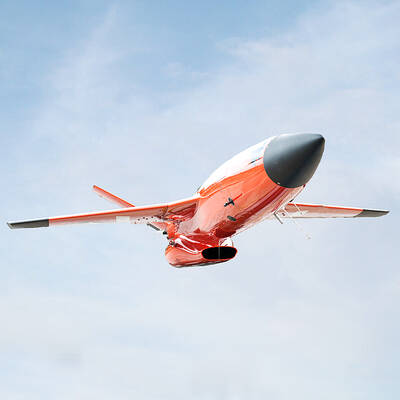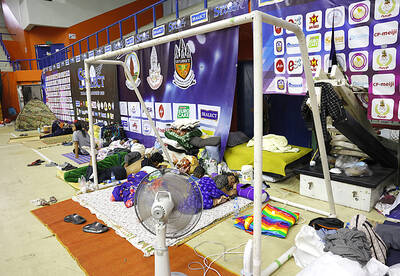There just isn't enough evidence to support the increasingly popular hypothesis that Asian economies are "decoupling" from a slowing US.
Markus Rosgen, who is Citigroup Inc's chief Asia strategist in Hong Kong, says the notion that the region has its own self-sustaining growth and doesn't have to sink or swim with the US "is a case of hope over reality."
The ratio of consumption in Asian nations' GDP, he says, has declined over the last five years.
While the US share of Asian exports has fallen -- to 17 percent last year from 23 percent in 1985 -- the intra-Asian trade that has replaced it moves in lockstep with US imports.
The correlation between the growth in intraregional Asian exports and US non-oil imports has increased sixfold in the past 25 years or so, Rosgen's analysis shows.
Ditto for the flow of capital: Stock indexes in Asia are more linked with US -- and European -- benchmarks now than they have been in 30 years, Rosgen says.
Even US patent records show that Asia's decoupling from the West is going to be a long-drawn process.
The flow of knowledge isn't getting the attention it deserves in the decoupling debate, which remains largely focused on movements of trade and capital. This is odd considering that throughout history the rise of new economic nerve centers has essentially been triggered by spurts of innovation.
K-WAVES
Economist Joseph Schumpeter called them K-waves, in honor of the Russian academic Nikolai Kondratiev, who devised a theory of 50-year-long business cycles of booms and busts.
George Modelski, a University of Washington political scientist, says the maturing of printing techniques in China in the 10th century was the first K-wave, while the arrival of Intel Corp's microprocessors in the early 1970s is the starting point of the 19th -- and the most recent -- one.
All the waves have started as concentrated bursts of activity that gradually spread in all directions; their primary effect has been to make the host economy rich for two generations, or about 50 or 60 years, and then dissipate.
Viewed from this prism, the brisk economic activity in Asia that is being touted as proof of decoupling may be just what one would expect to see in the diffusion phase of a disruptive technology -- such as the Internet -- - that was hosted elsewhere.
Together with excess telecommunications capacity created during the dot-com bubble, the Internet has made it possible for many tasks -- from analysis of X-ray reports to remotely monitoring the shop-floor inventory at a Detroit automaker -- to be outsourced to the Asian region cost-effectively. Yet, outsourcing is still about satisfying final Western demand.
US PATENTS
The current technological cycle won't make Asia a new economic powerhouse; it may set the stage, but the spark will have to come from within. What that innovation might be remains unknown. However, after it does arrive, it will be seen -- with the benefit of hindsight -- as a new 20th wave, or K-20.
What we are witnessing now is the buildup phase of Asia's scientific prowess. Analysis by Albert Hu, an economist at the National University of Singapore, shows that three-fifths of US patents granted to innovators in seven East Asian countries cite prior work done in the US, a figure that has actually risen a little since the early 1990s.
That isn't surprising. There are many more US patents for Asian innovators to cite from than there are Asian ones, as Hu said in a recent paper cowritten with Milan Brahmbhatt, lead economist for Asia-Pacific at the World Bank.
KNOWLEDGE HUBS
Remove that difference from the equation, and the picture begins to look brighter, especially for South Korea and Taiwan, two of the most technologically advanced countries in Asia outside Japan.
Increasingly the building blocks of South Korean or Taiwanese scientists -- the "prior art" in patenting lingo -- are coming from within their own country or from other Asian nations.
"After controlling for the fact that the potential pool of citable electrical and electronics patents is much smaller than the potential pool in the US, [South] Korean patents cite other [South]Korean patents almost five times as intensively as they do US patents," Brahmbhatt and Hu note.
To a lesser extent, the same is true of Taiwan. Apart from building on the technologies developed by their compatriots, researchers in Taiwan are also making three times more use of South Korean inventions than they are of US patents.
"These trends confirm the growing regional dimension in East Asian knowledge flows," the economists say.
The emergence of local knowledge clusters is crucial for Asia. They will lead to specialization and improve the odds of big-bang innovation, which, in Schumpeter's scheme of things, is the biggest tool any entrepreneur can lay his hands on to "creatively destruct" existing hegemonies.
Until that happens, prosperity in Asia will be subservient to Western demand. And that automatically means that another prerequisite for a decoupled economy -- freedom in setting fiscal and monetary policies -- won't be available to Asian policy makers for many years to come.

‘WIN-WIN’: The Philippines, and central and eastern European countries are important potential drone cooperation partners, Minister of Foreign Affairs Lin Chia-lung said Minister of Foreign Affairs Lin Chia-lung (林佳龍) in an interview published yesterday confirmed that there are joint ventures between Taiwan and Poland in the drone industry. Lin made the remark in an exclusive interview with the Chinese-language Liberty Times (the Taipei Times’ sister paper). The government-backed Taiwan Excellence Drone International Business Opportunities Alliance and the Polish Chamber of Unmanned Systems on Wednesday last week signed a memorandum of understanding in Poland to develop a “non-China” supply chain for drones and work together on key technologies. Asked if Taiwan prioritized Poland among central and eastern European countries in drone collaboration, Lin

The Chien Feng IV (勁蜂, Mighty Hornet) loitering munition is on track to enter flight tests next month in connection with potential adoption by Taiwanese and US armed forces, a government source said yesterday. The kamikaze drone, which boasts a range of 1,000km, debuted at the Taipei Aerospace and Defense Technology Exhibition in September, the official said on condition of anonymity. The Chungshan Institute of Science and Technology and US-based Kratos Defense jointly developed the platform by leveraging the engine and airframe of the latter’s MQM-178 Firejet target drone, they said. The uncrewed aerial vehicle is designed to utilize an artificial intelligence computer

Renewed border fighting between Thailand and Cambodia showed no signs of abating yesterday, leaving hundreds of thousands of displaced people in both countries living in strained conditions as more flooded into temporary shelters. Reporters on the Thai side of the border heard sounds of outgoing, indirect fire yesterday. About 400,000 people have been evacuated from affected areas in Thailand and about 700 schools closed while fighting was ongoing in four border provinces, said Thai Rear Admiral Surasant Kongsiri, a spokesman for the military. Cambodia evacuated more than 127,000 villagers and closed hundreds of schools, the Thai Ministry of Defense said. Thailand’s military announced that

CABINET APPROVAL: People seeking assisted reproduction must be assessed to determine whether they would be adequate parents, the planned changes say Proposed amendments to the Assisted Reproduction Act (人工生殖法) advanced yesterday by the Executive Yuan would grant married lesbian couples and single women access to legal assisted reproductive services. The proposed revisions are “based on the fundamental principle of respecting women’s reproductive autonomy,” Cabinet spokesperson Michelle Lee (李慧芝) quoted Vice Premier Cheng Li-chiun (鄭麗君), who presided over a Cabinet meeting earlier yesterday, as saying at the briefing. The draft amendment would be submitted to the legislature for review. The Ministry of Health and Welfare, which proposed the amendments, said that experts on children’s rights, gender equality, law and medicine attended cross-disciplinary meetings, adding that